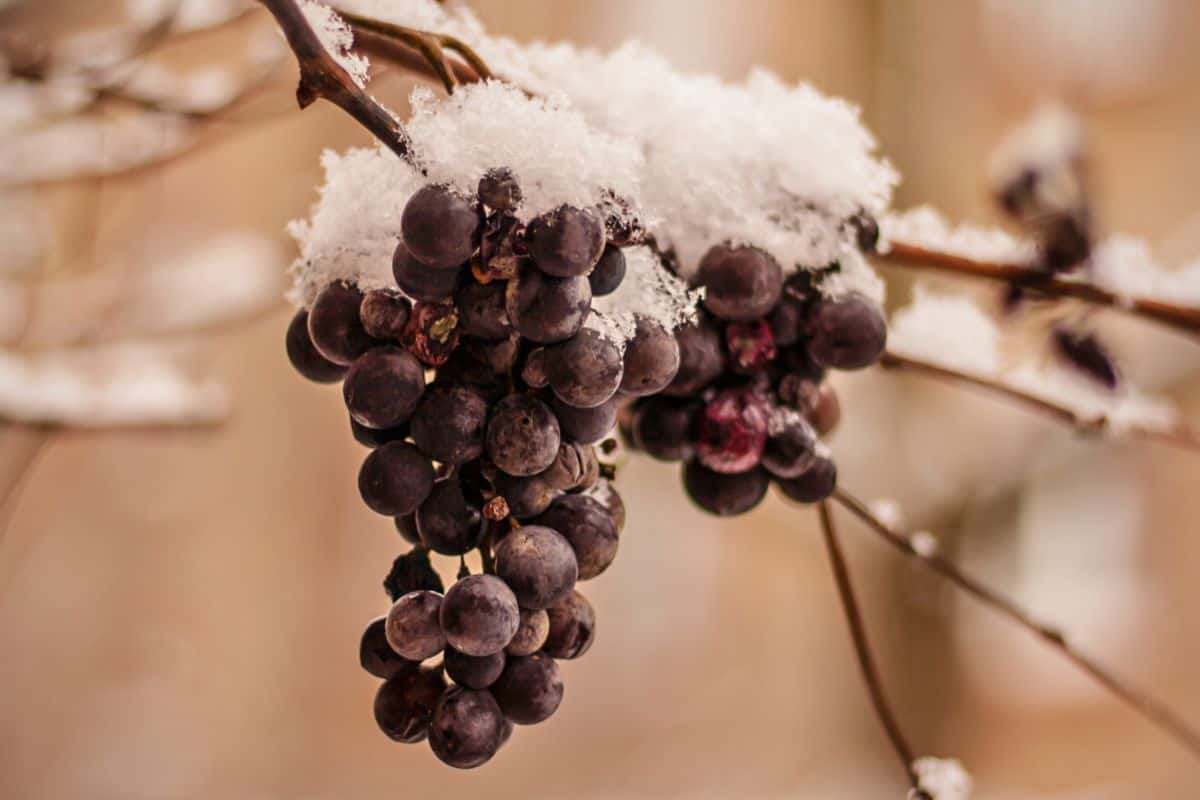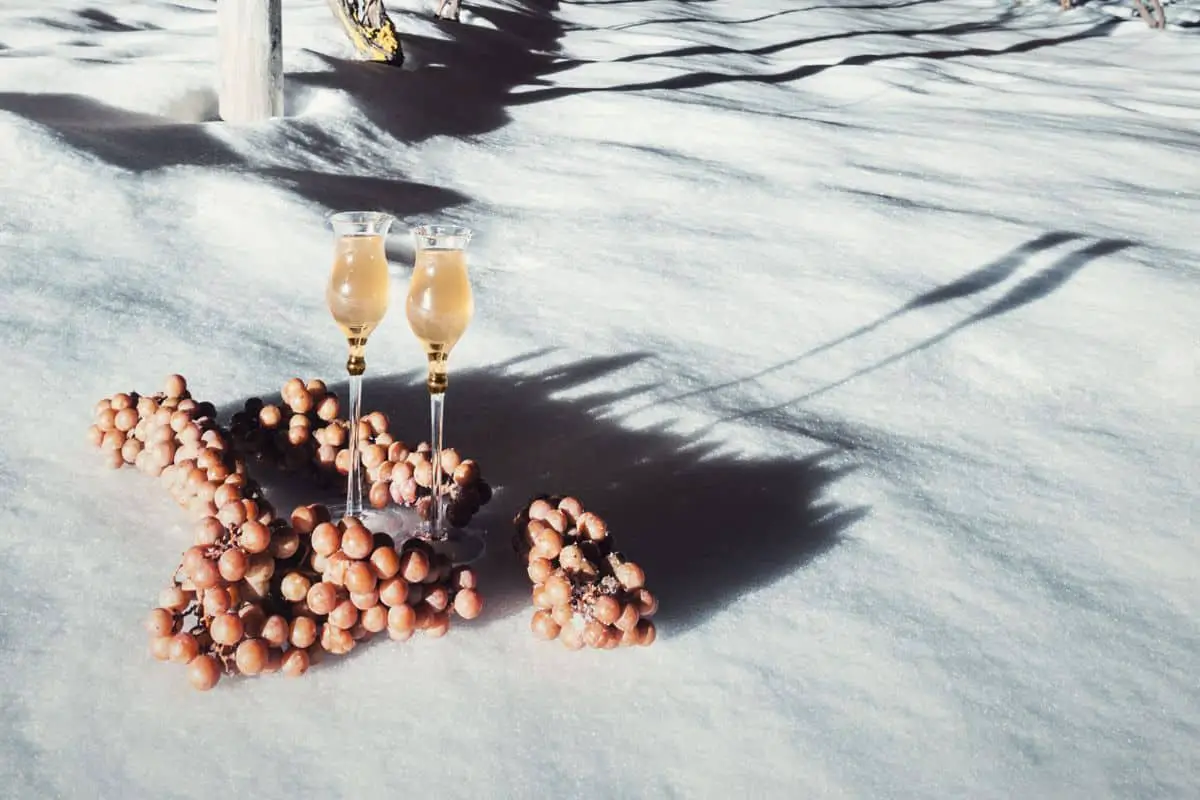Ice wine: it’s not as popular as your Merlot, Pinot or Sauvignon, but it’s definitely just as tasty. Ice wine is no ordinary wine.
Ice wine is produced in specific conditions, using methods that aren’t common in the production of other wines.
The result? A super-sweet, super-concentrated wine, with a pretty high price point.

If you’ve got a sweet tooth, ice wine is the ideal dessert wine.
It’s also made in both red and white variations, with each type bringing different flavor profiles to the table.
It’s a truly distinctive and diverse wine, and if you haven’t tried it already, you’ll definitely want to after this.
Ready to learn more? Stick with us to explore the ins and outs of the infamous ice wine.
What Is Ice Wine?
Ice wine sometimes pronounced ‘Eiswein,’ is a variety of sweet wine that was traditionally produced in Germany and Austria.
It’s now also produced in Canada and China. Ice wine is a dessert wine that’s made with grapes that have been frozen on the vine.
This wine has a high sugar content and high acidity, with an ABV of around 10%.
The grapes most often used to produce ice wine can include Riesling, Cabernet Franc, Vidal, and Gewurztraminer.
Unfortunately, ice wine can be a challenge to make. Grapes must be handpicked, and harvests must be timed with precision, which can often lead to low yields.
These factors give ice wine a much higher price point than other wines – in fact, you can expect to pay in excess of $100 a bottle!
It’s not entirely clear when ice wine was first discovered, but according to legend, it was a complete accident.
In the 18th century, winemakers in Germany accidentally left a few grapes on the vine during a particularly cold winter.
When they came to press the grapes, they found that each one had been frozen solid, but they continued to press them anyway.
When they finally created the wine, it had a unique, pronounced flavor, and the technique for making ice wine then became widespread by the mid-1800s.
What Does Ice Wine Taste Like?
When we say ice wine is a sweet wine, we mean it. Ice wine is about as sweet as wine gets, and it’s produced to be as sweet as possible.
You can expect to taste hints of peach, apricot, citrus, honey, and tropical fruit in your ice wine. Some bottles even have undertones of strawberries and light spices.
Ice wine tends to be medium to full-bodied and comes in red and white versions.
Red ice wines are the variety that often has strawberry and spice notes, whereas white ice wines tend to be more fruity and light.
Because ice wine can be made with various grapes, not all bottles will taste the same.
Ice wine made with Vidal Blanc, for example, will still have distinctive fruity flavors, but it may boast some tropical undertones, too.
Ice wine made with Riesling has a different flavor profile and may have more pronounced hints of stone fruit.
Red ice wines, like those made with Cabernet Franc, will still be exceedingly sweet, but they may embody more spicy qualities, with hints of currants and rhubarb.
Why Does Freezing Grapes Make The Wine Sweeter?
When grapes are frozen, the water is driven out of the fruit, intensifying the flavor.
As the grapes try to survive the freezing temperatures, they’ll expel all that extra water. If they don’t, this water will crystalize and kill the grape.
To survive the freeze, the grapes will also increase their own sugar content to give them additional energy – hence that distinctive, sweet flavor of ice wine.
Toward the end of the growing season, ice wine grapes will freeze and re-freeze.
Each time this happens, the intense flavor profile of the grapes increases, producing a sweeter wine.
How Is Ice Wine Made?

Although many parts of this process resemble the processes used to make other wines, some key differences exist.
The biggest difference happens right in the middle of growing when grapes are left to freeze on the vine.
Once the grapes are frozen, they are picked as quickly as possible and pressed.
However, growing ice wine grapes requires plenty of care and attention.
Temperatures must be kept as low as -8 degrees before the grapes can be picked, especially if you want the super sweet, super-concentrated ice wine.
Harvests will usually take place overnight, too – preferably in the winter, when vineyards are cold and covered in snow.
Grapes are typically harvested in mid to late November, depending on the region.
Although harvesting casualties are rare, this does make grape picking significantly more dangerous for workers harvesting ice wine grapes.
Once the grapes are picked, they’ll experience more chilly conditions.
The grapes will end up in a specifically chilled hand pump, and care is taken to ensure the water crystals remain in the press while the juice freezes at a lower temperature than the water.
Then, the sugar and acid levels are increased. The end result? An expressive, medium-bodied wine with citrus and floral notes and a crisp, clean finish.
Ice Wine Food Pairings
Ice wine is famously sweet, and it’s commonly consumed as a dessert wine. Some ideal food pairings for white ice wine include:
- Fruits such as strawberries, peaches, and pears
- Creme Brulee
- Cheese Cake
- Apple Pie
- Oysters
- Fritters
Red ice wine can be paired with foods such as:
- Almonds
- Pecans
- Walnuts
- Rhubarb
- Chocolate
- Cheese desserts
Either wine can also be consumed with cheese. Some popular cheeses include Roquefort, Pecorino, Grana Padano, Chevre, and Gorgonzola.
Final Thoughts
Ice wine is one of the most unique wines in the world.
It’s not something you’d find easily at your local grocery store though, and you can expect to pay FAR more than your average bottle of sauvignon blanc or chardonnay.
However, ice wine is unbeatable if you want a super-sweet, crowd-pleasing dessert wine to satisfy your soiree.
Whether you’re a red or white drinker, you’ll find a bottle to suit every palette and almost every type of food.
- How to Learn Wine Tasting: Essentials for Beginners - March 10, 2024
- How to Learn to Like Wine: Cultivating an Appreciation for the Vintner’s Art - March 10, 2024
- Thanksgiving Sangria: A Flavorful Twist to Your Holiday Table - August 27, 2023








